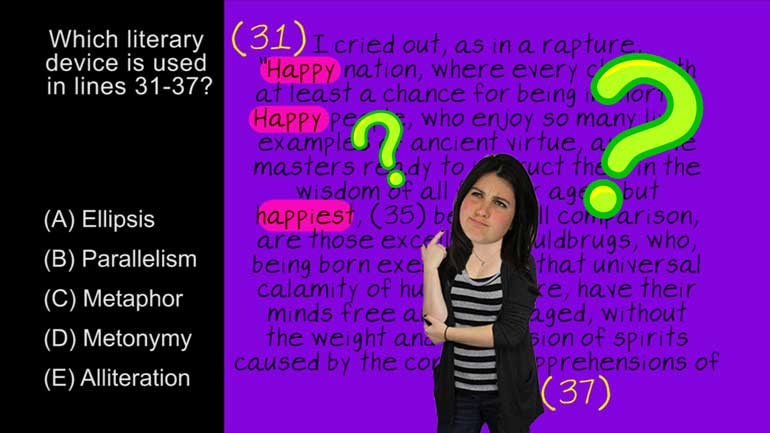ShmoopTube
Where Monty Python meets your 10th grade teacher.
Search Thousands of Shmoop Videos
Unit 1.3 Negative Numbers 119 Views
Share It!
Transcript
- 00:07
Ever felt like a zero?
- 00:08
Yeah. Not fun. [Man on a bench with his head in his hand]
- 00:10
Now can you imagine feeling like LESS than a zero?
- 00:14
Seems impossible, doesn’t it? Well, thanks to the number line, nothing is impossible. [Number line waving]
- 00:22
You see that? number line just totally made the statue of liberty disappear.. Incredible!
Full Transcript
- 00:27
When it comes to numbers, they don’t just represent stuff you can see, or hold in your
- 00:32
hands.
- 00:32
“One” is easy to wrap our heads around, because we can see one of something. [Man wraps number 1 around his forehead]
- 00:37
But…negative 1? What in the world is that?
- 00:40
Negatives are actually used to help us understand some pretty complex ideas by allowing us to
- 00:45
assume that every positive number has a partner on the opposite side of zero on the number line. [positive and negative numbers on a number line]
- 00:50
But for now…don’t worry about those complex ideas.
- 00:52
The important thing is to understand the basics of how negative numbers work.
- 00:56
You know you’re looking at a negative when you see a number preceded by a negative sign…
- 01:01
one of these little dashy things. [negative symbol circled]
- 01:04
If we see negative 3, for example, that symbol is telling us that this number exists three
- 01:08
units to the left of zero on the number line.
- 01:11
If we see negative 455, well…we’re going to need a bigger monitor. [dog walking on a beach]
- 01:17
What happens when you add one negative number to another?
- 01:21
By adding two negatives, we’re basically saying, “Hey…if we start this many units
- 01:25
left of zero…and then we go x number of units further away from zero…where will
- 01:31
we end up?”
- 01:32
The answer? Pretty darn far away from zero.
- 01:35
Like… negative 5 plus negative 6 is negative 11. [-5 + -6 calculation above a number line]
- 01:39
Just as, on the other end of the number line, 5 plus 6 is positive 11.
- 01:46
When we subtract one negative from another, on the other hand, the signs cancel…
- 01:50
…and the result is that we’re actually moving in the direction of zero.
- 01:54
Negative 8 minus negative 3 is the same as negative 8 plus positive 3…
- 02:00
…or negative 5.
- 02:02
If we start with negative 1 and subtract negative 7, we’ll cross over zero completely and [negative 1 circled on a number line]
- 02:07
wind up at positive 6.
- 02:09
Don’t forget to stop and say hi to zero on the way. It gets awfully cranky when it [man with number zero for a face looking cranky]
- 02:13
feels ignored. Okay, now what about when we add one positive
- 02:16
and one negative?
- 02:18
“Adding a negative” is really the same as subtracting…
- 02:21
…so 9 plus negative 4 is another way of saying 9 minus 4…which is 5.
- 02:28
Ine-nay inus-may orr-fay is yet another way of saying 9 minus 4, but… it won’t help [pig talking]
- 02:34
us here, so let’s move on. If you ever add a negative number to its corresponding
- 02:40
positive number, you’ll get zero. Every. Time.
- 02:43
Go ahead. Try a few hundred of ‘em. You’ll see. [young child sleeping]
- 02:52
Finally, you can multiply or divide negatives.
- 02:55
Whenever you multiply or divide one negative by another negative, the signs will cancel out
- 02:59
and you’ll come up with a positive result.
- 03:02
One positive and one negative…and the result will be negative.
- 03:06
Commit these rules to memory, and you’ll be well ahead of the curve.
- 03:09
Well, ahead of the line anyway. [Number line takes off top hat and is squashed by statue of liberty]
- 03:11
Isn’t he marvelous?
Up Next
When you're about to marry the love of your life, not many things could stop you. However, finding out that your future hubby is keeping his crazy...
Related Videos
Here at Shmoop, we work for kids, not just the bottom line. Founded by David Siminoff and his wife Ellen Siminoff, Shmoop was originally conceived...
ACT Math: Elementary Algebra Drill 4, Problem 5. What is the solution to the problem shown?
AP® English Literature and Composition Passage Drill 1, Problem 1. Which literary device is used in lines 31 to 37?
AP® English Literature and Composition Passage Drill 2, Problem 1. What claim does Bacon make that contradicts the maxim "Whatsoever is delig...




